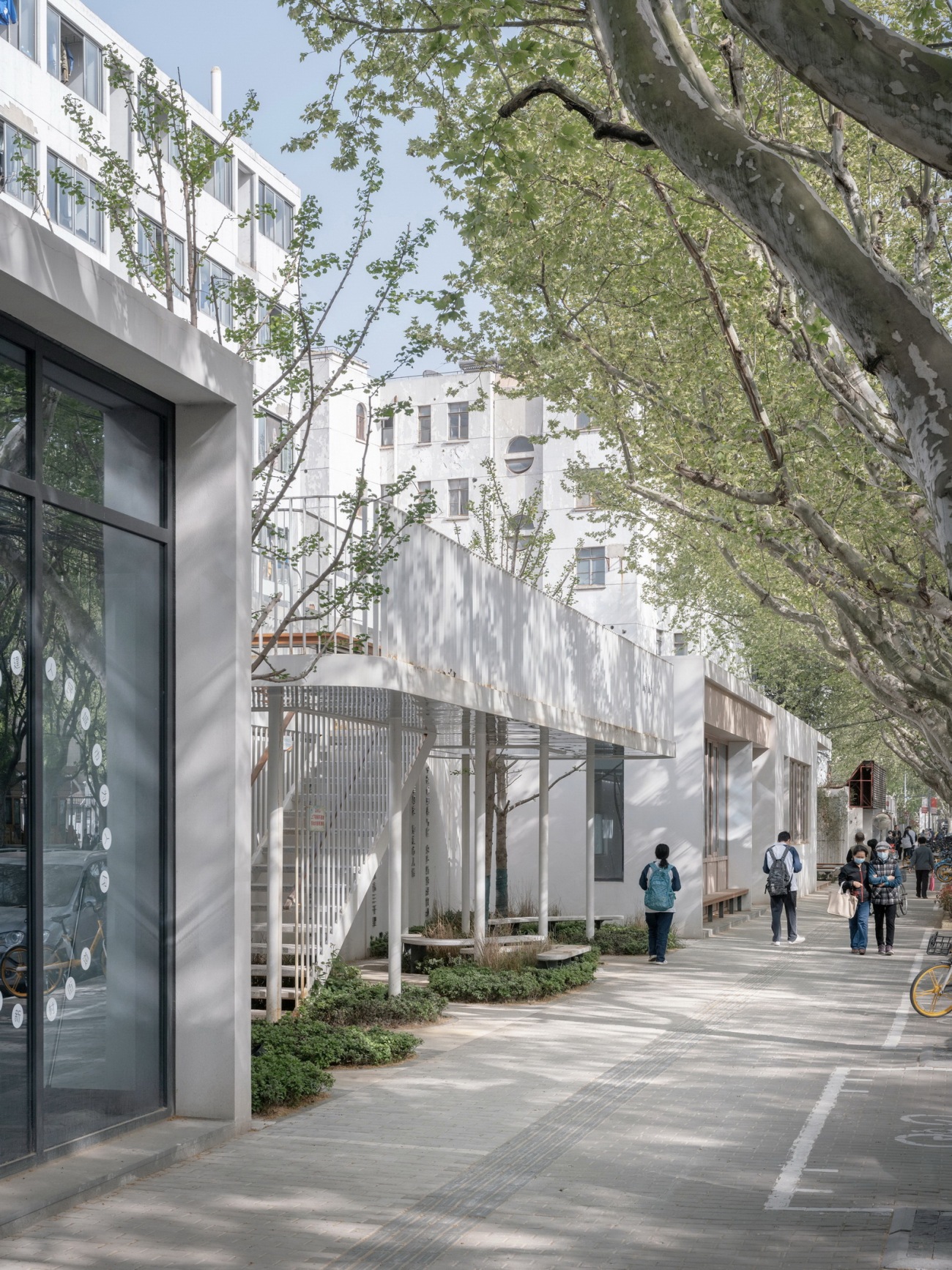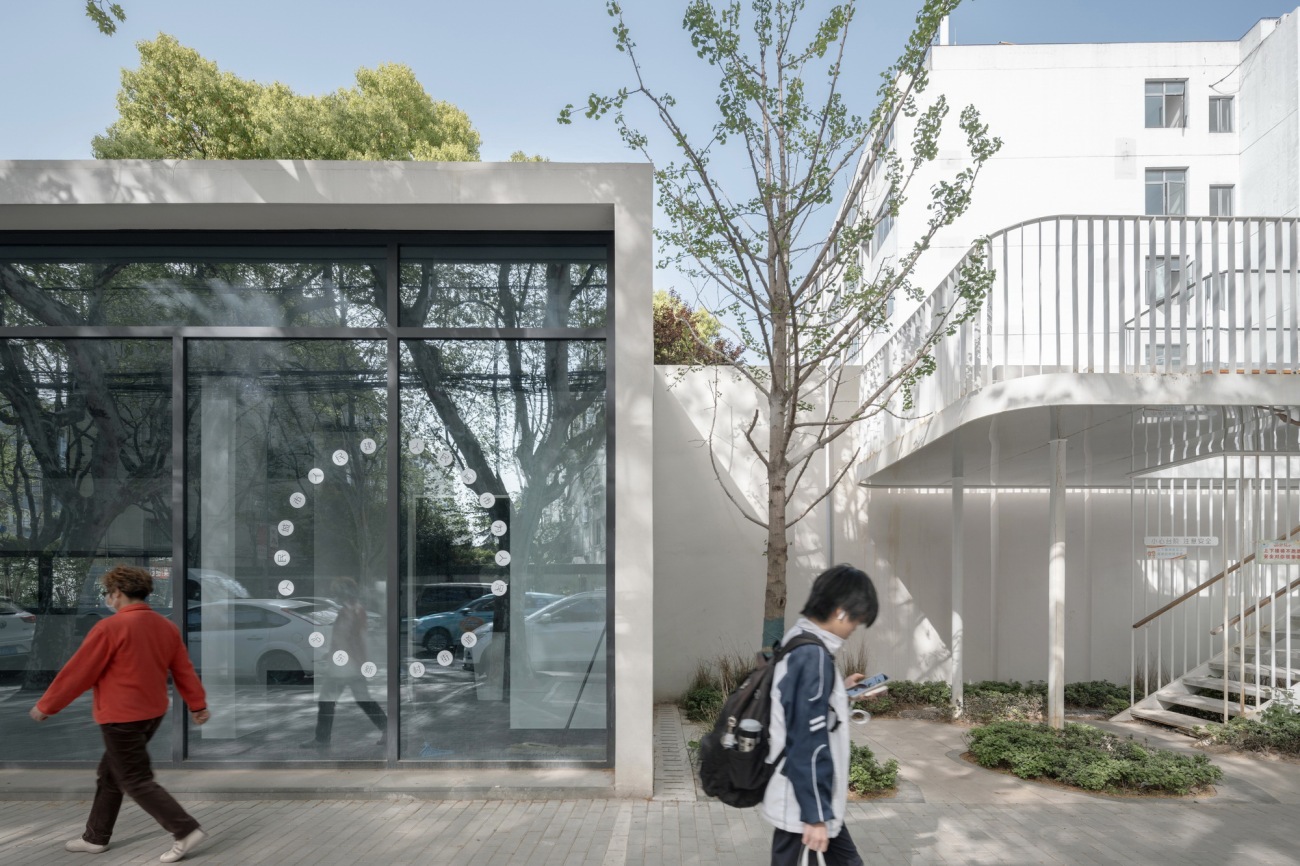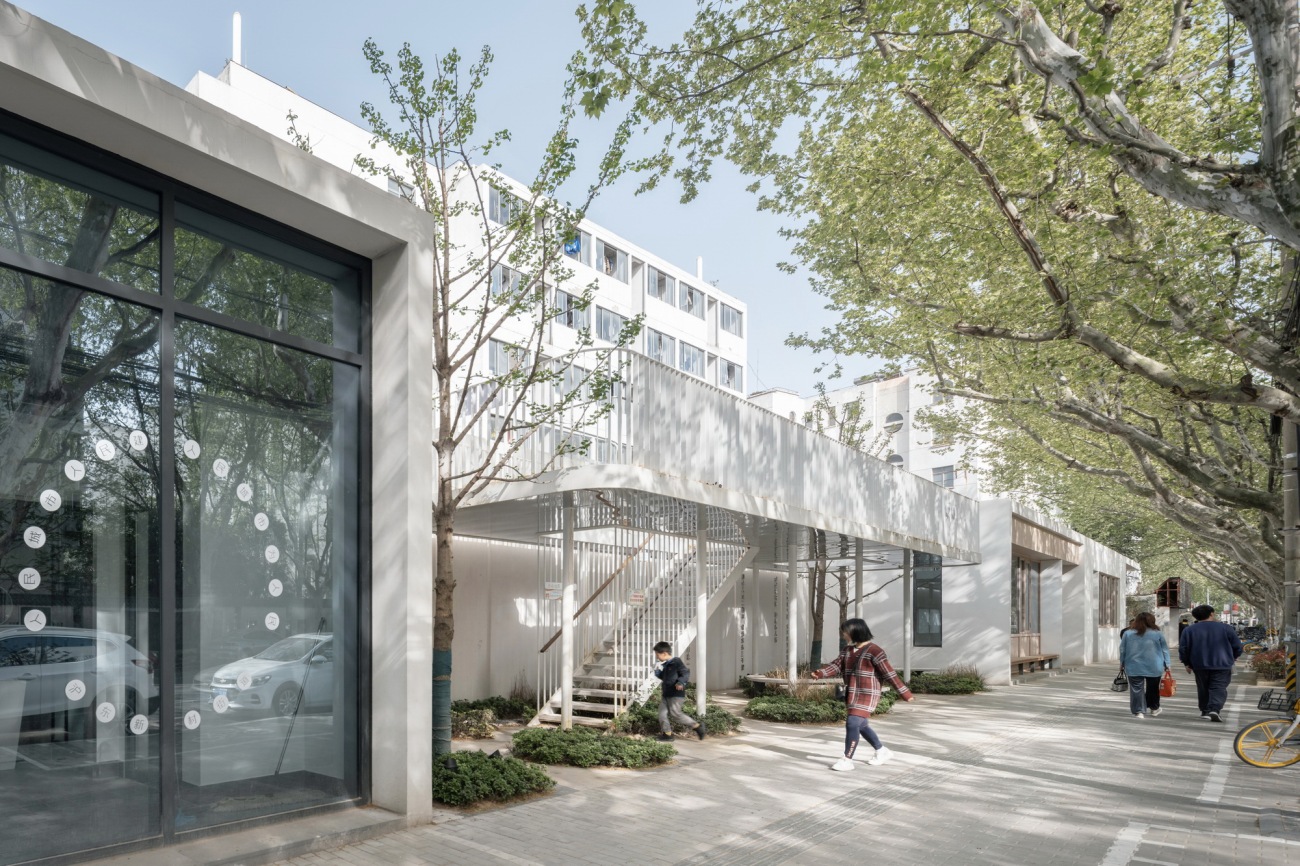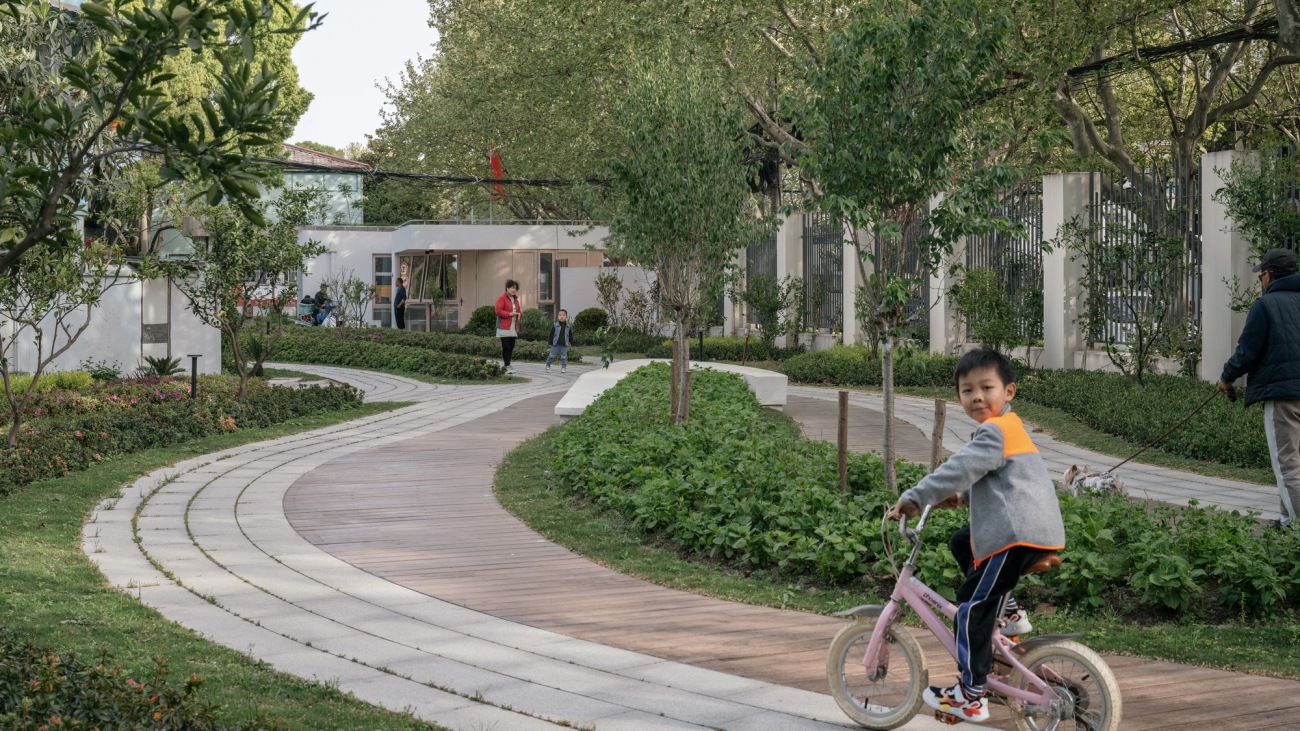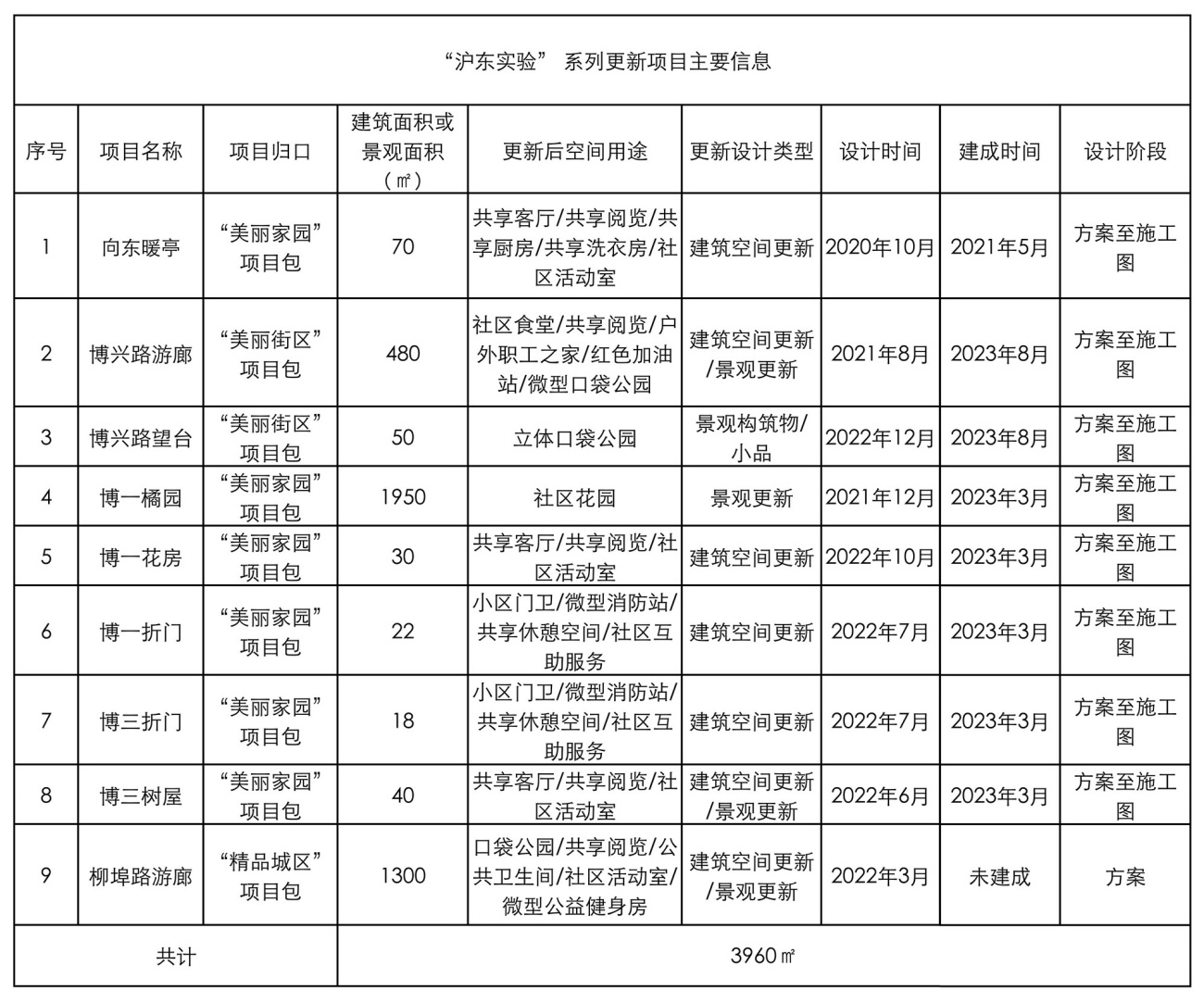▽“向东暖亭”是“沪东实验”的起点
▽“博兴路游廊”与“望台”一起重构社区公共空间界面与公共生活
沪东新村最早建于1953年,因沪东造船厂建造的职工住宅而得名,是新中国成立后上海建设的第一批工人新村之一。经历上世纪50年代、90年代和21世纪初三个集中建设期,历时70余载,如今的上海市浦东新区沪东新村街道(以下简称“沪东”)是具有代表性的以老旧小区为主的高密度社区。这类社区沿街界面多以老小区和单位围墙、沿街商铺等构成,呈现出“公共性”不足的特征,可供居民活动和提供公共服务的空间较少。2020-2023年,VIA在沪东“博兴路-柳埠路”沿线开展渐进式系列更新实验,从设定“空间原型”、建立“空间模式”、设定“要素特征”,到响应环境的“空间意象转译”、有机嵌入“公共生活”,为社区沿街界面的有机更新探索出一条自下而上的实践方法和路径。
Hudong community which was initially built in 1953 is one of the first residential communities built to accommodate local workers after 1949. Having gone through three major construction periods in the 1950s, 1990s and the first decade of 21th century, Hudong has become one of the typical high density communities of old residential area in Shanghai. According to the lack of publicness in Hudong neighborhood space, VIASCAPE design(VIA) started a series of experimental community renewal projects by setting up spatial prototypes, establishing space patterns then gradually getting down to sorting out typical characteristics, design elements, spatial image translation and finally generating organic embedded-in design from 2020 to contribute to a bottom-up method for community regeneration.
▽“沪东实验·第一章”系列更新点位分布图
▽沪东新村街道区位图
▽“沪东实验”各点位更新前现状
1. 渐进的系列更新
A Continuing Series Renewal
沪东的系列更新起点是VIA于2020年5月创作的“向东暖亭”1。在仅70平方米的有限建筑空间里,创新的结构设计为使用者争取了更大、更完整的空间体验,在近人尺度中形成温暖的公共生活。至2023年,我们基于沪东的更新需求,又陆续完成了“博兴路游廊”、“博三树屋”、“博三折门”、“博一折门”、“博一花房”“、博一橘园”、“博兴路望台”、“柳埠路游廊”等8处小微空间的设计。由于这些项目源于不同的政府工作项目包、不同年份的工作计划(见表1),整个更新过程虽然因此历时而缓慢,但同时也为实验式的更新设计提供了更多的踏勘调研、公众参与、试错纠错的机会。
Hudong Experiment of serial renewal began with the PAVILION 1 which was designed by VIA in May 2020. Until 2023, we have completed 8 micro space renewal design in Hudong, which are the GALLERY of Bo'xing Road, the TREE-HOUSE of Bosan, the DOOR of Bosan, the DOOR of Boyi, the FLOWER-HOUSE of Boyi, the ORANGE-ORCHARD of Boyi, the VIEWING-DECK and the GALLERY of Liubu Road. These projects were designated from different government project package with various time schedule (see Table 1), therefore we encountered a lengthy and complicated process. But it offered an opportunity for more detailed survey, adequate public participation and design experiment as well.
在初期研究这些更新点位时,我们发现,所有点位大多沿着博兴路与柳埠路的沿街界面散点布局,且每2个相近点位之间大约为3至5分钟的步行距离。这种间距和密度可以成为公共空间界面嵌入一系列公共服务、提供公共活动场所的契机。经与沪东新村街道办事处工作团队(以下简称“街道”)研究商议,2020年下半年起,我们以“系列更新”的方式、以全局化整体提升社区公共界面的视角开展工作,摸索基于空间更新模式创新的工作方法。
Through spatial analysis, we revealed that these projects were mostly located sporadically along Bo'xing Road and Liubu Road with approximately 3-5min walk distance in between, which perfectly fits the requirements of the public service radius and open space activities embedding. After several conferences with Hudongxincun sub-district office, we started to work on a holistic community public space regeneration in a way of serial renewal named as Hudong Experiment by us.
2. 建立隐藏的秩序
Establish the Hidden Order
“看不见的‘隐藏的秩序’确保了城市的续存。”
──[日]芦原义信
从博兴路、柳埠路沿线现状看,街道空间除了人行道以外,少有公共开放空间。因此,每个更新点位都应该是一个提供社区公共生活的机会。在满足具体功能需求(社区活动室、社区食堂、小区门卫、24小时社区事务受理等功能)的同时,每个点位在空间上的“虚”“实”关系设立就成为了整个系列更新设计的基础,“实”空间提供公共服务、“虚”空间引导户外交往。在“虚实空间”的原型基础上,设计可根据具体点位的环境特性、使用功能、活动需求、治理需求等方面综合分析,通过“并列”“叠加”“变形”等方法将“原型”演化为每个具体点位的“空间模式”,从而逐步构建博兴路-柳埠路沿线的公共界面空间秩序。
In the context of lack of open space along Bo'xing Road and Liubu Road, Hudong Experiment prioritized creating spaces to provide public service and hold public activity at each renewal project. While meeting the functional requirements of community activity rooms, community canteens, security guards and 24-hour community affairs processing, we established a spatial prototype of "void and solid" as the foundation of Hudong Experiment. The public service will be provided in the solid space and the void space is to accommodates outdoor social activities. And we developed several spatial patterns by the method of juxtaposing, overlying and transforming the spatial prototype according to each renewal project's different spatial feature and functional demands. A hidden order was thus established along Bo'xing Road and Liubu Road in Hudong Experiment.
在展开具体设计之前,我们对更新建构方式与要素特征也设定了一系列原则:①以融入社区基础风貌而非追求设计的自我表现为目标,用简洁的设计语言和低成本、易实施、去装饰的建造方式进行空间更新;②基于使用者体验,将每个“虚”空间设计为有覆盖的灰空间或有明确边界围合的“正空间”2“阴角空间”3,并加强“虚”空间活动与“实”空间内部功能的互动;③在建筑的公共界面及开放空间中尽可能多的设置座椅设施,形成融入整体空间关系的“座席景观”4,以此鼓励较长时间的开放空间使用;④尽可能在各更新点位中植入便于管养的乔灌木,以更绿色生态的方式营造社区公共空间;⑤在“实”空间中更多的使用玻璃等具有视觉“透明性”(transparency)特征的材料构件,让室内的活动或服务成为有趣的街景,吸引潜在的社区居民参与;⑥更新要为未来可能的功能调整与展陈装饰保留一定的弹性空间。
And we set up a series of design principles before the specific design. They are: integrating community landscapes with simple design language to fulfil low-cost construction in a de-decorative method; making every void space to be a grey space to combine indoors and outdoors activities, or setting up boundaries to make it to be a "positive space" 2 or a "concaved space"3; more seat facilities should be integrated into the renewal design to create the "seat landscape"4 and encourage long-term use of open space; apply low-maintenance plantings; more transparent materials like glass should be used in solid spaces to let indoor activities be viewed as streetscape; keep the flexibility for potential functional adjustment.
本次系列更新以“空间模式建立+空间特征要素设定”作为实验性工作方法探索的第一阶段,希望以此建立满足空间需求、符合在地特征的“隐藏的秩序”5而非通过强烈的设计表达或具有某种风格的设计去武断地改变社区面貌。
The process of developing the spatial patterns and setting up the design principles is the very important and experimental exploration of the serial renewal design. Then we can weave the community open space following the "hidden order"5 rather than change it by some arrogant design.
3. 空间意象转译与环境响应
Spatial Image Translation According to the Context
▽空间原型与各点位空间模式演化
▽基于空间意象转译与环境响应的设计形体生成
从“空间模式”落实到具体点位设计,存在三种完全不同的场地现状条件,需要有与不同特征环境响应的“转译”方法。第一类是占地极小的项目,需以创新的设计手法释放空间潜能。如向东暖亭、博三折门、博一折门、博一花房等点位,占地分别为50㎡、18㎡、22㎡、30㎡。在向东暖亭的设计中,以“亭”上实下虚的空间意象转译实现原型“叠加”,并将公共客厅、公共洗衣房、共享游戏空间等功能布置在全开放的“虚”空间中。在博一折门、博三折门的设计中,以“正在打开的门”的空间意象完成原型“变形”,将安保管理、信息发布、街头休息、爱心互助、微型消防站等功能融合在一起,将传统意义的门卫空间转型为小区居民接受社区服务的第一站。而在博一花房点位的设计中,则强化了社区活动室功能空间面向社区花园的开放性,营造“花房”的美好意象。
As to the specific design, we "translated" the spatial pattern into actual space that respond to the environment based on the conditions of three different types of sites. The design of the PAVILION, the DOOR of Bosan, the DOOR of Boyi and the FLOWER-HOUSE of Boyi faced the similar site situation of minimal space. How to find some innovative approach to activate the space potential is the key point of the design. In the case of the PAVILION, the spatial pattern was translated into the image of "pavilion". The "void space" is at the 1st floor where the public laundry, community living room, children's playground are placed in, and the "solid space" for reading is at the 2nd floor. When we designed the DOOR of Boyi and the DOOR of Bosan, the spatial pattern transformed from the prototype was translated into the image of the "opening door", in which functions like security guards, billboards, street seating, community aid and micro fire station are all integrated. The traditional sentry box is then transformed into a service station for residents. And as to the FLOWER-HOUSE of Boyi, we established and strengthened the space connection and experience continuity between community home and he community garden to create an image of "flower house".
第二类的博兴路游廊、柳埠路游廊是拆违后沿街封闭空间的改造,通过本次更新为社区提供更多室内外公益功能空间。以博兴路游廊为例,设计在拆违空间中植入社区食堂、社区共享阅读、社区志愿者之家、户外职工休息活动室等公共服务功能,并将超50%的占地用于公共或单位的景观空间(其中近一半恢复为东侧相邻学生公寓的绿地空间)。同时,基于沿街长80米、进深5米的用地特征,以空间原型在博兴路街头“并列”的方式、通过折叠的空间界面设计实现“游廊”的空间意象转译。
There were full of illegal buildings without permits that should be abolished in the site of the the GALLERY of Bo'xing Road and the GALLERY of Liubu Road. Public welfare functional space and outdoor activities were suggested to placed in it by the sub-district office. Taking the GALLERY of Bo'xing Road as an example, functions like the community canteen, shared reading space, and the living room for outdoor workers are incorporated. And more than 50% area of the site is assigned to be landscaped space in our design. As to the specific design, we translate the the spatial pattern from juxtaposing the prototype into a "gallery" with a folding space design language.
第三类的博三树屋、博一橘园在具体更新设计上都采取了与现状社区绿化积极响应的策略。博三树屋虽然是社区闲置用房活化利用更新,但设计不仅将现状白玉兰保留下来,并将白玉兰作为最重要的环境要素融入空间原型的“虚”空间中,以树与屋有机结合方式凝结小区居民共同记忆。博一橘园的环境响应则更具社会意义,通过利用小区居民原先在用地角落中密集种植的30余株橘树在场地中的优化布局,实现社区花园的全过程共建。正是基于不同现状条件的特征认知与类型分析,沪东实验摆脱了传统微更新就事论事的工作方式,采用以社区公共空间营造为导向的“空间意象转译”与融汇社区既有绿色、人文资源的“环境响应”的创新实验方法达成了各更新点位的设计建构。
In the design of the TREE-HOUSE of Bosan and the ORANGE-ORCHARD of Boyi, we establish a strong connection between renewal design and existing planting. The TREE-HOUSE of Bosan is centered by the existing Magnolia tree, and the organic combination of the tree and the building is designed to be a local common memory. And the public participation that more than 30 orange trees planted 10 years ago by a local couple were rearranged in the community garden by themselves with design team gives the ORANGE-ORCHARD of Boyi more social significance. Based on deep research, we develop an experimental design method co-responding to environmental feature and existing resource in Hudong Experiment rather than the traditional renewal way.
4. 织补日常图景
Weave the Daily Scenes
“建造不仅是一种再现,也是一种日常生活的体验。”
──[美]肯尼斯·弗兰姆普顿
▽”沪东实验“以各更新点位织补社区日常图景
以沪东博兴路-柳埠路公共界面的围墙为例,由于沿线各单位和小区建设年代不同,围墙也样式各异,现在看来虽不算优美,但在当时都经过仔细设计与用心建造,且在历时积淀后,从社区整体视角看却呈现出一种属于沪东的朴素、真实的韵味与风貌。这种属于老旧社区公共界面共有的普遍特性,是构成沪东社区居民日常生活“底图”的重要内容。
As an old community, Hudong has a large number of public interfaces composed of residential fences designed and built in different eras with different styles. Although these public interfaces may not be elegant and beautiful from a contemporary aesthetic perspective, they have formed a simple and authentic community style belonging to Hudong. And this common feature of old communities is an important part of the "base map" of local daily life in Hudong Community.
因此,“沪东实验”不仅关注部分封闭界面的有效打开、社区公益职能与公共服务内容的植入、相邻杂乱空间的梳理,更关注各更新点位“嵌入”日常生活界面的方式。在各点位的建筑、景观、小品、标识等公共空间要素的具体设计上,采用更朴素简洁的、“去个体表现”的方式,以引导公共活动的整体空间关系把握作为要点,以更新后博兴路-柳埠路沿线公共空间中真实发生的社区生活为主要呈现内容。并以这些温暖、生动的公共生活为媒介将本次系列空间更新与社区环境中既有的稳定风貌进行有机的编织与连结,织补与完善社区日常生活图景,并以此追求在地“场所精神”6的延续与发展。
Hudong Experiment concerns not only opening up the enclosed boundary, implanting community services and reorganizing open space, but the way how to embed every renewed project into daily life as well. A simplified and de-decorative design language is adopted in this serial renewal in order to let the civic life rather than some wonderful design be seen as streetscape. So the real life along Bo'xing Road and Liubu Road can weave every renewal project with the daily scenes into integrity, and maintain the "Genius Loci"6 of Hudong community.
5. 自下而上的社区规划
A Bottom-up Community Planning
在3年多的过程中,各点位的更新设计成果一方面要分别多次接受市容、房管多个主管部门的项目指导,同时也不断主动对接规划、绿化、路政等部门以及产权单位的实施管理要求,我们与街道始终坚持“15分钟社区生活圈”的整体工作思维,以整体社区规划的全局视角出发开展工作。沪东是高度建成地区,可挖潜的系统性开放空间资源有限,通过“沪东实验”系列更新,以自下而上的角度,在现状“难以规划”的空间状态中寻找内在的关联、建立隐藏的秩序,通过“空间原型设定–空间模式建立–要素特征设定–空间意象转译/环境响应–有机嵌入–公共生活呈现”的创新社区规划方法,将散布的各点位融入整体社区风貌,将现状单调、枯燥的空间界面转化为居民共享的、呈现多元美好社区公共生活的“凝聚的缝合线”7。
Although undergoing dozens of design reviews and evaluations from multiple administrative department in past 3 years, which made our design work really difficult. We still tried to make this serial renewal be a holistic community planning with the "15-minute community life circle" thought. Hudong community is a highly built area with limited systematic open space resources in Shanghai. We employed a bottom-up planning/design method to establish a hidden order for "hard to be planned" space. In Hudong Experiment the innovative planning method that is "set up spatial prototype—establish space patterns—set up design principles—design with spatial translation—embed into public life" is applied to make these sporadically located project sites weaved into the community, transferring the old and boring community interface into a shared, multifunctional "stitching line"7 for public life.
在更趋精细化的社区更新工作背景下,“自上而下的精英规划难以解决所有问题”8,“沪东实验”中全过程的社区居民参与是自下而上社区规划的重要内容。各更新点位的方案开展多轮意见征询,考虑每一位居民的需求和意见,不断完善设计。以博三树屋为例,征询中因为小区75号楼的一位居民的反对意见而展开重新设计,并在多次点对点沟通后,组织新一轮小区居民代表(扩大)听证会、75号楼全体居民签字认可等民主程序确定方案。这个磋商的过程以“权力委任”(Delegated Power)9的方式将决策权让渡给居民,让居民“实质性参与”(Degrees of Citizen Power)9社区更新。在博一橘园的更新中,小区的一对老年夫妇主动提议将他们之前种的橘树用于社区花园的建设,并对橘园的营造从策划到植物移植、养护等多方面提供支持与协助。随着社区更新工作的持续开展、“15分钟社区生活圈”理念的深入人心,沪东居民对社区公共事务的参与程度越来越高,对社区美好生活空间的追求也逐步上升到具有自觉意识的主动共建共治共享,这是也是“沪东实验”中最令人欣喜的成果与华彩。
In the context of more refined community renewal requirement, "traditional top-down planning can hardly solve all problems "8. Public participation plays an important role in Hudong Experiment. Multiple levels of survey and public hearings were held to improve design. In the case of theTREE-HOUSE of Bosan, we gave up the original scheme only due to objections from one resident. And one more public hearing was conducted before reaching a consensus, this process gave local residents the right to decide, and maximized the "Degrees of Citizen Power"9, which follows the rule of "Delegated Power"9. And in the case of the ORANGE-ORCHARD of Boyi , an old couple spontaneously donated their orange trees for the community garden renewal, and offered sufficient support and suggestions during the whole design-construction process. As the "15-minute community life cycle" thought spreads, the continuing community renewal process stimulates the public participation enthusiasm of Hudong residents. The mindset of co-construction, co-governance and shared benefits is awakening in neighborhood. This may be the most exciting part of Hudong Experiment.
▽“沪东实验”各社区公共服务空间内部利用情况
▽“博兴路游廊”中近期完成软装开放的户外职工驿站及阅读空间
▽“向东暖亭”日常社区居民活动视频截图
注释:
Notes:
[1]“向东暖亭”详细信息见VIA维亚景观以“暖亭:黄浦江畔的社区之家”为题发表在各专业学术媒体的文章,同时该项目获得了2023“上海建筑学会第十届建筑创作奖”优秀奖(一等)、2023年上海市“15分钟社区生活圈”优秀案例等荣誉,“暖亭”模型也于2024年被中国建筑模型博物馆收藏。
[2] [美]克里斯托弗·亚历山大 等. 王听度, 赵序鸿译. 建筑模式语言: 城镇·建筑·构造.北京:知识产权出版社,2022: 1009.
[3] [日]芦原义信. 尹培桐 译.街道的美学(上).南京:江苏凤凰文艺出版社,2017: 73.
[4] [丹麦]扬·盖尔. 何人可 译.交往与空间.北京:中国建筑工业出版社,2002: 165.
[5] [日]芦原义信. [日]伊藤增辉 译.隐藏的秩序.南京:江苏凤凰文艺出版社,2023: 95.
[6] [挪]诺伯舒兹. 施植明 译.场所精神:迈向建筑现象学.湖北: 华中科技大学出版社,2010: 180.
[7] [美]凯文·林奇. 方益萍,何晓军 译.城市意象.北京: 华夏出版社,2017: 48.
[8] 张帆,葛岩.治理视角下城市更新相关主体的角色转变探讨——以上海为例[J].上海城市规划,2019(5):57-61.
[9] Arnstein. S.R., A. Ladder of Citizen Participation, Journal of American Institute of Planners, Vol. 35, No.4, July 1969. 216-224.
[1] For more details about "the PAVILION", please refer to VIASCAPE design's article titled "the Pavilion: A Community Home nearby Huangpu River " published in various professional academic media. And this project has won honors such as the Excellent Award (First Class) of the 10th Architectural Creation Award of the Shanghai Architectural Society in 2023 and the Excellent Case of the "Shanghai 15 Minute Community Life Circle" in 2023. "The Pavilion" model was also collected by the China Architecture Model Museum in 2024.
[2] Christopher Alexander, A Pattern Language: Towns·Buildings·Construction, 1977.
[3] Yoshinobu Ashihara. Machinami No Bigaku. 1979
[4] Jan Gehl, Life Between Buildings[M]. the Danish Architectural Press,1971.
[5] Yoshinobu Ashihara. Kakusareta Chitujyo. 1986.
[6] Christian Norberg-Schul. Genius Loci: Towards a Phenomenology of Archtecture[M]. Mondadori Electa,1980.
[7] Kevin Lynch. The Image of the City (Harvard-MIT Joint Center for Urban Studies Series). 1960.
[8] Zhang Fan, Ge Yan. Research on the Multi-players' Concept and the Role Transformation in Urban Regeneration under the Perspective of Governance: A Case Study of Shanghai [J]. Shanghai Urban Planning Review, 2019(5):57-61.
[9] Arnstein. S.R., A. Ladder of Citizen Participation[J]. Journal of American Institute of Planners, Vol. 35, No.4, July 1969. 216-224.
▽“沪东实验”系列更新项目主要信息
主要项目信息
Project Information
项目名称:沪东实验(博兴路-柳埠路沿线社区公共空间系列更新)
设计单位:VIA维亚景观
主持设计师:孙轶家、周密
设计团队:孙轶家、周密、马丽、吉文山、易洋帆、蔡颖、刘习文、敬波、纪慧敏、姚维彦、赵非齐、巩红蕾、计雨薇、马乔、卓杰、陈露、赵广叶、许亮、沈沉
设计时间:2020年10月至2022年10月
建成时间:2021年5月至2023年8月
设计总规模:3960平方米
项目地址:上海市浦东新区沪东新村街道博兴路、柳埠路沿线
各更新子项名称:
业主单位:上海市浦东新区沪东新村街道办事处
代建单位:上海社发浦众建设管理有限公司
施工单位:上海依航建筑装饰工程有限公司、上海浦林城建工程有限公司
标识设计:VIA维亚景观
标识字体授权:锐字潮牌字库
照明顾问:OUI light 徐越峰
游廊局部室内展陈:宾酷文化
摄影师:CreatAR Images
撰文:孙轶家
图纸绘制:计雨薇、马乔
Project: Hudong Experiment( Serial Renewal Design along Bo'xing Road & Liubu Road)
Design firm: VIASCAPE design (VIA)
Lead Designer: Sun Yijia, Zhou Mi
Design Team: Sun Yijia, Zhou Mi, Ma Li, Ji Wenshan, Yi Yangfan, Cai Ying, Liu Xiwen, Jing Bo, Ji Huimin, Yao Weiyan, Zhao Feiqi, Gong Honglei, Ji Yuwei, Ma Qiao, Zhuo Jie, Chen Lu, Zhao Guangye, Xu Liang, Shen Chen
Design time: from Oct. 2020 to Oct. 2022
Built time: from May. 2021 to Aug. 2023
Design area: Apx. 3960 sqm
Location: Along Bo'xing Rd. & Liubu Rd., Hudongxincun Sub-district, Pudong New Area, Shanghai
Client: Hudongxincun Sub-district Office, Pudong New area, Shanghai
Project managing consultant: Shanghai Shefapuzhong Construction Managing Co, ltd
Contractor: Shanghai Yihang Construction and Decoration Engineering Co, ltd, Shanghai Pulin Construction & Engineering Co, ltd
VI Design: VIASCAPE design
Fonts for VI: REEJI type
Lighting Consultant: OUI Light / Xu Yuefeng
Interior Exhibition Display: BGC
Photographer: CreatAR Images
Article Author: Sun Yijia
Design Drawings: Ji Yuwei, Ma Qiao
更新日期:2024-08-13 15:56:09
非常感谢 VIA维亚景观 带来的精彩项目, 查阅更多Appreciations towards VIASCAPE design for sharing wonderful work on hhlloo. Click to see more works!

